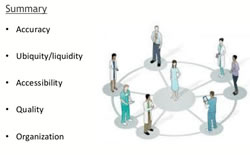In “From big data to smart data, processes and outcomes“, we emphasize the importance of the “action” aspect of data and big data. And with big data analytics we look at the importance of smart decisions.
Both highlight the need to turn data into insight, intelligence and action, enabling faster decisions, better real-time customer experience, optimized business process, etc. However, what makes data actionable?
What are the conditions data has to meet in order to become actionable? In a presentation at the Kodak Alaris Information Management Global Directions conference, Patti Dodgen, CEO at EHR (Electronic Healthcare Record) solutions and healthcare interoperability firm Hielix, looked at the characteristics of actionable data.
Even if the presentation mainly revolves around healthcare, certainly worth a look, especially as data consistency and quality are among the core challenges in healthcare.
Hielix summarizes the traits/aspects of actionable data in 5 categories.
1. Accuracy.

This is key to any data-driven process and a condition that needs to be fulfiled before we can even talk about actionable data. Accuracy means that the data elements are 1) correct, 2) legible, 3) valid and 4) equivalents
2. Accessibility.
The accessibility of data is a second condition/category. It revolves, among others, around: 1) data modalities, 2) device modalities and 3) user proficiency
3. Ubiquity/liquidity
This is where data/information exchange and (again) availability come into play: 1) interoperability, 2) persistency and 3) virtually available
Note: another expert, Brian Ahier, defines liquid data as machine-readable data that can be accessible via application-programming interfaces and are easily downloadable and available via third-party applications. According to a report by McKinsey & Company liquid health data could help reduce costs by 300 – 450 billion USD.
4. Quality
This category encompasses many elements including security, one of the core challenges in healthcare data. Quality is about 1) completeness, 2) duplication, 3)organization 4) security and 5) consistent definitions
5. Organization
Last, but not least, Hielix mentions the organization of data, where the ‘actionable’ dimension, among others involves 1) context, 2) logic, 3) dynamic parsing, 4) semantic consistency and 5) updated taxonomies






